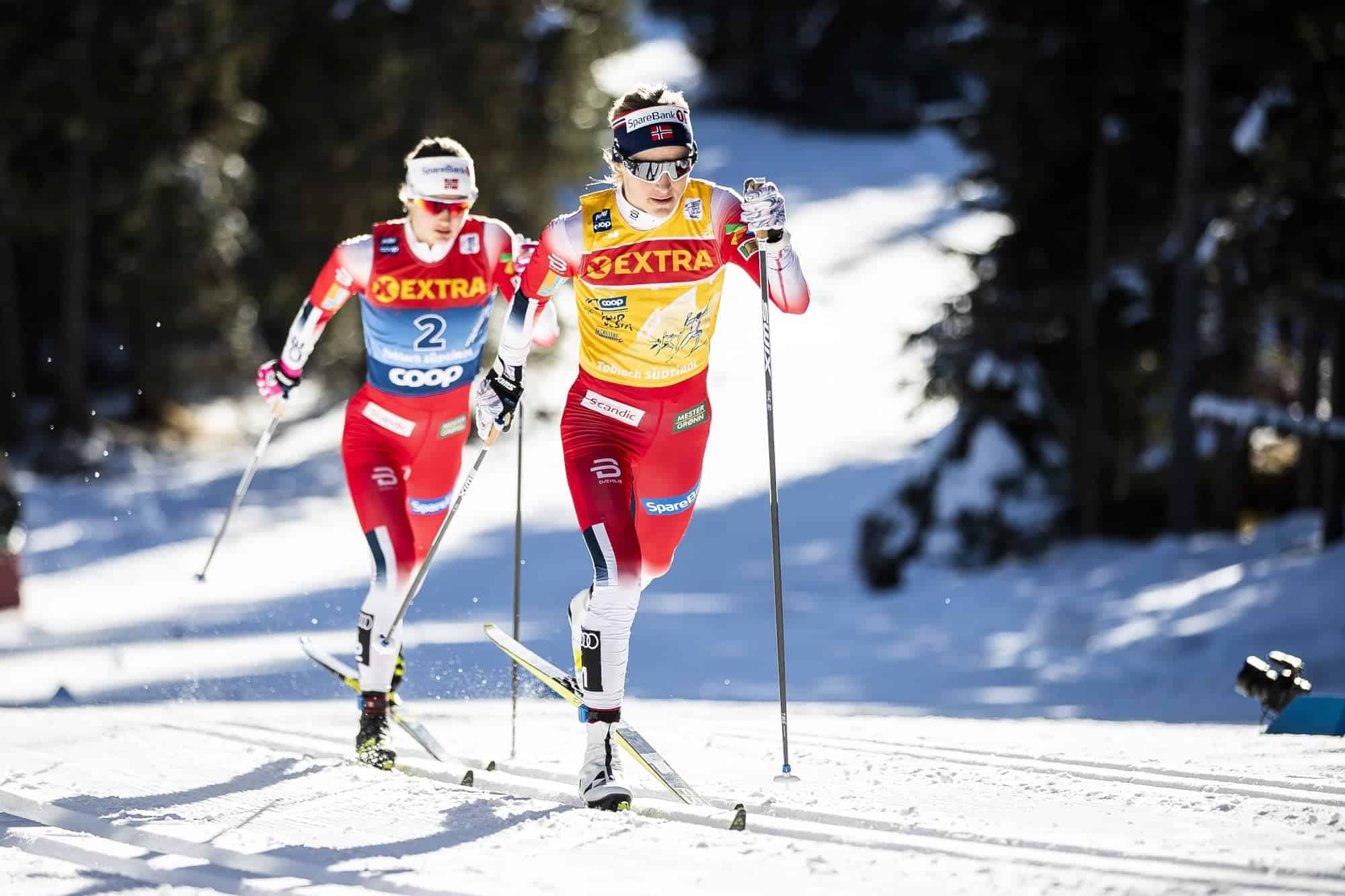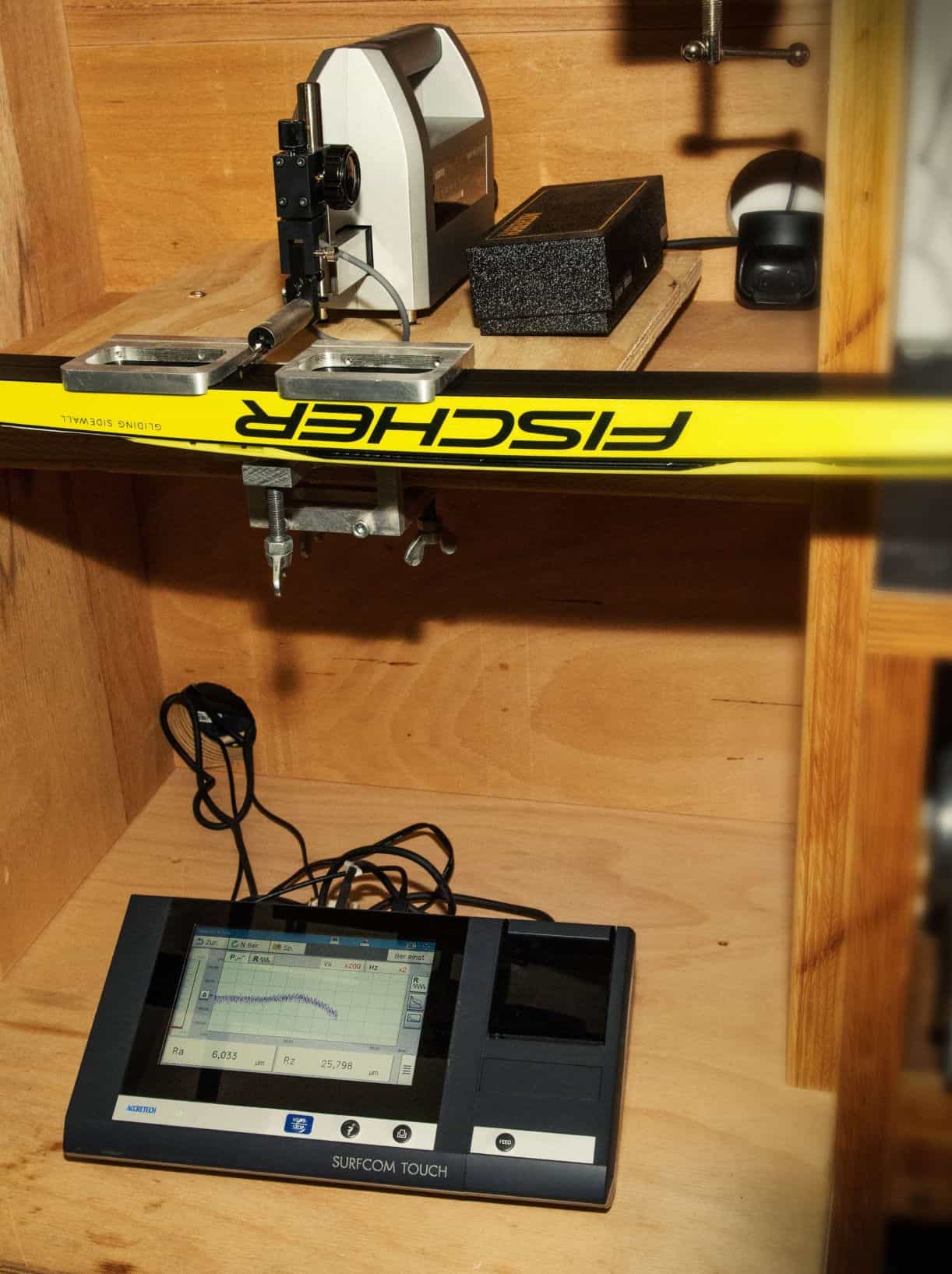A micrometer gives you the edge on the world champion
Fischer provides the skis for Nordic skiing’s global elite. One factor for success or failure is how the boards are cut. The manufacturer’s team of experts conduct measurements with an ACCRETECH SURFCOM TOUCH 50 to ensure that the skis have exactly the right roughness. This results in shorter setup times as well as better quality – and the instrument also features in the competition.
When Sebastian Stadlbauer carries out his work, it comes down to winning or losing. Stadlbauer is a member of ski manufacturer Fischer’s product development team, where he has responsibility for the skis of top athletes in the Nordic region. Part of his job involves taking care of the right cut.
This is a major factor in whether the athlete crosses the finish line first in cross-country skiing or in a biathlon – alongside other technical factors such as the ski itself and the wax. The cut determines whether a ski lies optimally on the trails, glides quickly, and is easy to steer.
Here, there is an almost infinite number of different groove patterns that are cut into the ski. The choice of pattern depends on the condition of the snow and on the individual preferences of the athlete.
Fischer, the global ski leader for the Nordic region, uses approximately 30 different structures. Their quality as well as that of the entire ski must meet the highest possible standards. After all, the company equips the vast majority of world-class cross-country skiers and biathletes.
“If our product isn’t right, then we’ve got a huge problem on our hands,” says Stadlbauer. “Because in top-level sport, we know that nuances can play a crucial role. If an athlete can glide and rest just ten centimetres longer when going downhill because of their ski, this can make all the difference.”
„If our product isn’t right, then we’ve got a huge problem on our hands”
Stadlbauer and his team rely on the ACCRETECH SURFCOM TOUCH 50 to measure ski profiles after production. The mobile roughness measuring instrument is used when a ski leaves one of the four grinders installed in Fischer’s production facility. These machines use a diamond to cut the special groove patterns into the grindstone, which then transfers them to the plastic surface of the ski.
“Once we have set the cut on the machine, we produce a test ski, which is then measured,” says Stadlbauer in explaining the procedure. “When we are within the permissible tolerance range with the measurement, we start grinding the skis.” Random samples are then taken to measure whether the surface roughness is OK or NOK . Fischer produces 100 to 200 skis per day in this way. 20 to 30 of these undergo random sampling.
“The number always varies somewhat,” says Stadlbauer. “There are cuts where you know that 50 skis can be produced without any problems. However, with other cuts, you need to check after 10 or 20 units.”
The measurement data obtained is stored and compared against each other. “This allows us to identify developments and assess whether we might have to change the stones or the diamond, for example,” says Stadlbauer. Here, it is good to be able to take a close look at the roughness curve.
From what experts tell us, setting the machine correctly is a challenge. There are many factors with the ability to influence the right cut. In addition to the stones and diamonds, the quality of the water that is used is one reason for this.
When Fischer tries out new profiles, they are initially cut on some skis. A test report is then created, before Stadlbauer and his team step onto the boards to test them. At the end of the day, they are all also passionate cross-country skiers. Using these tests, they then work towards the appropriate tolerance range for the roughness measurement.
The Ra-value, Ra-Max and Ra-Minimum as well as the Rz-value, Rz-Max and Rz-Minimum are relevant in this regard. “We look primarily at the Ra value and have a range of between 0.2 and 0.3 μm,” Stadlbauer adds. For example, it is then possible for a ski to have a cut with a Ra value of 2.2 to 2.4 μm.
Test laboratory confined to the history books – contour analysis directly on site
In addition to roughness measurements, Stadlbauer and his team also use the SURFCOM TOUCH 50 for contour analysis. “A cross-country ski always has a groove,” explains Stadlbauer. “And we conduct measurements with the instrument to determine whether the groove is exactly in the centre and whether its depth is correct.”
With the measuring instrument Fischer used before the SURFCOM TOUCH 50, such a contour analysis was not possible. They always had to take the skis to the test laboratory for analysis. Now Stadlbauer can conduct the measurements himself.
“You see, contour analysis was new territory for us at first,” he reports. This became apparent when making the settings on the SURFCOM TOUCH. It required a lot of effort. “It didn’t happen overnight. We had to play around with the programme a bit.”
That being said, the ACCRETECH support team was on hand immediately, the product developer notes. “We were quickly given advice, information and videos to show us the right way to proceed.”
SURFCOM TOUCH shortens setup times
Stadlbauer, on the other hand, didn’t need any in-depth support for the roughness measurement. He views the user-friendliness of the SURFCOM TOUCH 50 as one of its great strengths. “You save your settings once on the instrument, clamp the ski, and press the start button. That’s all there is to it.”
Menu navigation is very straightforward. Fischer was able to forgo hours of staff training.
According to Stadlbauer, it is also very easy to set the traversing speed on the SURFCOM TOUCH 50. You always get an exact value regardless of the speed. “This also works when you’re moving relatively quickly,” says Stadlbauer. Thanks to the ACCRETECH roughness measuring instrument, Fischer was also able to further improve the quality of its products.
The 50 mm traverse path offered by the SURFCOM TOUCH was also important to Fischer. “Not every instrument offers that – especially in this price range,” Stadlbauer adds. This makes it possible to measure the width of a complete ski, which is 44 mm. This means: the ski can be measured in a single procedure without having to turn it over again, which, in turn, shortens setup times.
Easy to use and mobile – even when you’re on the trail!
The fact that the SURFCOM TOUCH 50 is mobile is another advantage. “You can set it up anywhere,” Stadlbauer remarks. This was also true of the previous instrument. However: the user always had to take a laptop with them. In contrast, the SURFCOM TOUCH 50 can be operated via a 7-inch colour touchscreen display.
This feature of the surface measuring instrument is particularly relevant to Fischer. Because when athletes compete in world championships on the company’s skis, Stadlbauer or one of his colleagues is also at the event. They take the grinders and the SURFCOM TOUCH 50 with them in their luggage. At major competitions like this, every effort is made to equip the athlete in the best possible way. For example, Fischer’s experts get the profile of the skis back into top condition the night before the big race. Using the SURFCOM TOUCH 50, they then check whether the ski has the μm-precise roughness to make its user a world champion.
The company
Fischer Sports GmbH is the global market leader in Nordic skiing and one of the world’s leading brands in Alpine skiing. Fischer is also one of the largest manufacturers of high-quality ice hockey sticks. The privately run company has almost 2000 employees and was founded in 1924 in Ried im Innkreis, Austria. The town is still home to the company’s head office. Production takes place in Ried im Innkreis and in Ukraine.
Contact
ACCRETECH SBS UK Ltd
Tim Wood
Regional Director North Europe, ACCRETECH SBS UK Ltd
Unit 2, Leofric Court Progress Way
CV3 2NT Coventry
woodt@accretech.eu
Phone +44 (0) 2476 651 774




